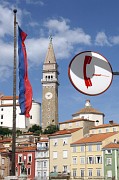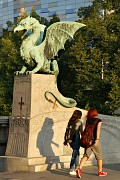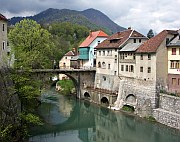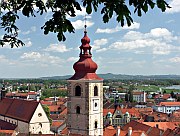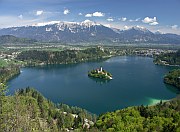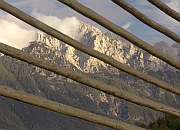This website is an archive from 2016
This site was actively maintained from 2006 to 2016. Since then I have kept it online for historical interest, but have made no further updates. Much of the information in these pages is now incorrect or obsolete.
Slovenia | Introduction
The expression "small but perfectly formed" could have been coined for Slovenia. Any journey through the country is likely to be short, but will probably feature unspoiled countryside, quaint towns, castles and Baroque churches perched on hilltops, and somewhere in the background the towering peaks of the Julian Alps. Slovenia is one of the easiest European countries in which to travel - an ideal choice for a relaxing break.
Slovenia is often excluded from definitions of the Balkans, due to its long connection to Central Europe and the absence of Byzantine or Ottoman influences, so arguably it doesn't belong in a website called "Balkanology". If I had to choose between describing it as "Balkan" or "Central European" I would probably choose the latter. Fortunately I don't have to make any such choice, and see no reason why it can't be both. Perhaps for no better reason than because Slovenia was the first place I ever ate burek...
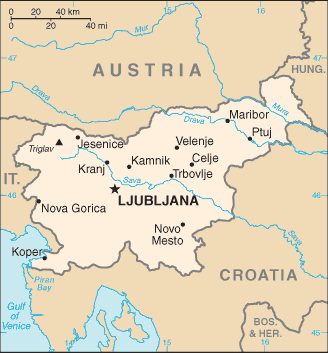

Where to go: some suggestions
Ljubljana is conveniently located in the centre of the country. It's one of Europe's smaller capital cities, but makes up in charm what it lacks in size or imposing monuments. It's easy to spend a few days here doing nothing very much at all; it's also an excellent base for day trips to many of Slovenia's other attractions.
Southwest of Ljubljana is the intriguing Karst region. The interaction of water and limestone has created oddities such as the disappearing lake at Cerknica and the natural arches at nearby Rakov Škocjan gorge. The most popular attractions are Postojna and Škocjan Caves. The latter is slightly harder to get to but it's well worth the effort. It's also close to Slovenia's short stretch of coastline, where the Venetian streets and squares of Piran stand out among a string of otherwise unmemorable resorts.
A short journey northwest of the capital brings you to the Julian Alps. Everyone goes to Bled, and with good reason - even if you've seen a hundred postcards of Lake Bled's island church you're bound to want to take your own photos. But there is much more to explore in this corner of Slovenia. Peaceful Lake Bohinj is deeper in the mountains than Bled and the starting point for many hikes along well-marked trails. Further still to the northwest is Kranjska Gora, another good base for both serious hikes and gentle valley walks.
The road south from Kranjska Gora climbs via a series of spectacular hairpin bends to the Vršič Pass, which is followed by an equally thrilling descent to the Soča Valley, one of the most interesting parts of Slovenia. The valley's position on the front line in the First World War has left several interesting museums and monuments around Bovec and Kobarid. If that sounds a bit too serious, there are plenty of good hikes in the area, along with more energetic activities such as rafting and climbing.
Appealing small towns are scattered around Slovenia. Although few have any unmissable sights, many have attractive mediaeval centres, and there is usually a castle, church, or museum to visit. Three examples are Ptuj, Kamnik, and Škofja Loka. The last of these makes an excellent excursion from Ljubljana, especially combined with a hike up nearby Lubnik mountain - this is no Alpine peak but it does reward you with views over a large chunk of Slovenia.
Practicalities
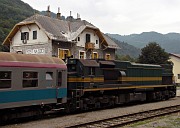
Transport
Domestic road and rail networks are centred on Ljubljana. Trains are cheaper than buses, usually comfortable and modern, and quite fast in the case of the slick "ICS" services to Maribor. However many interesting places are not served by trains, so you will probably end up using buses quite a lot. (See the FAQ for advice on getting to Bled and Bohinj). Buses are run by a variety of operators but bus stations, and even bus stops in the middle of nowhere, have combined timetables. Both train and buses services vary greatly depending on the day of the week and time of the year, resulting in timetables where the annotations take up far more space than the timetable itself. So keep an eye out for departure times written in special colours or with mysterious strings of letters beside them.
Ljubljana has excellent international train connections, making it easy to reach most neighbouring countries plus more distant ones such as Germany. However travel to and from Italy is not always as convenient as you might expect - there is only one awkwardly-timed direct train, and bus services at weekends are limited.
Money
Slovenia adopted the Euro as its currency at the start of 2007, so its colourful Tolar notes are quickly becoming a thing of the past. As you might expect, Slovenia is not nearly as cheap as the likes of Bulgaria or Romania, but given the high quality of most things it still represents decent value by Western European standards.
Language
Slovene is one of the South Slavic languages, related to but distinct from Croatian and Serbian. Slovenia is probably one of the easiest European countries in which to travel, a huge proportion of the population seems to know English and be confident speaking it (many speak German and Italian too). I frequently encountered bus drivers and staff in small train stations who spoke at least some English, to an extent rare in almost any other European country (East or West).
